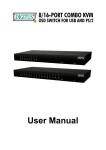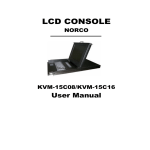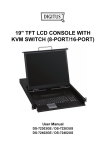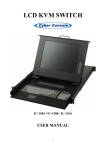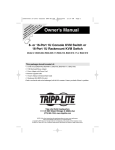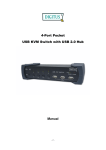Download Digitus USB-PS/2 Combo-KVM switch
Transcript
(Audio support optional) User’ s Manual 1. Introduction Thank you for your purchasing our KVM Switch! You now have a high quality, durable system that will enable you to control 2/4 Host computers and/or servers by using PS/2 and/or USB Connectors from one console (PS/2 or USB Mouse, PS/2 or USB Keyboard and one Monitor) with or without Audio – depending on choosen KVM Switch. Combo KVMs: DC-11101-1 (2-Port), DC-12101-1 (4-Port), DC-11301-1 (2-Port, Audio), DC-12301-1 (4-Port, Audio) USB-PS/2 Combo KVMs: DC-11202-1 (2-Port), DC-12202-1 (4-Port), DC-11401-1 (2-Port, Audio), DC-12401-1 (4-Port, Audio) 1.1 1. 2. 3. Features Console your Keyboard/Mouse via either way of PS/2 and/or USB arbitrarily. Complex connections with PCs via either way of PS/2 and/or USB arbitrarily. Controls 2 / 4 computers from a single console (Keyboard/Mouse) over PS/2 and/or USB connections. 4. Supports Windows, Linux, Mac OS9/OSX, Sun Microsystems. 5. 6. 7. 8. 9. 10. 11. 12. 13. 14. Emulates a keyboard on each PC to allow your computers to boot normally without a keyboard error. Supports hot-swap. All devices connected to the KVM can be added or removed at any time, without shutting the unit down. Supports 2 types of switching: (1) Hardware Push Button, (2) Hot-Keys on PS/2 and/or USB of keyboard arbitrarily. Supports Auto-Scan function to alternate video between computers in preset intervals. Supports LED display for PC status monitoring. Supports VGA resolutions up to 2048 x 1536 @ 85HZ. Supports Beeper during switching enabled. Self powered through PS/2 and/or USB connection. Fully compliant with the USB 1.1/ 2.0 specification. Audio support IN / OUT (only audio version) 1.2 Package Contents The product you purchased should contain the following equipment and accessories: 1. 2-Port or 4-Port KVM Switch with PS/2 and/or USB console ports 2. 2 pcs. KVM cable sets, 1,8m 3. User Manual 2 2. Specifications 2.1 General Specification Number Of Computers Controlled 2/4 Selection Method Push Button and Hot-Key (PS/2 and/or USB Keyboard) LEDs Red for PC Selection Green for PC On-Line ready Video PC Connectors 2 / 4 x HDB -15 female ( USB & PS/2 signal combined ) Speaker 2 / 4 audio female jacket (only audio version) Microphone 2 / 4 audio female jacket (only audio version) Keyboard 1 x 6 pin PS/2 mini-DIN female 1 x USB A type female (only USB –PS/2 version) Mouse Console Ports 1 x 6 pin PS/2 mini-DIN female 1 x USB A type female (only USB –PS/2 version) Video 1 x HDB -15 female Speaker 1 x audio female jacket (only audio version) Microphone 1 x audio female jacket (only audio version) Auto-Scan Interval From 5 to 250 Seconds DDC, DDC2 monitor Yes (Max. Resolution: 2048x1536) @ 85Hz Hot Swappable Yes Operating systems supported Windows 98SE/ME/2000/XP/2003 Server, Linux Mac OS9/OSX and Sun Micro System Device driver No Need Power By PS/2 and/or USB or External Power Adaptor (Optional) Dimensions (L X W X H) 2-Port : 14.0 x 8.5 x 4.5 cm (5.5 x 3.3 x 1.7 inches) 4-Port : 21.5 x 8.8 x 4.5 cm (8.5 x 3.4 x 1.7 inches) Unit Weight 2-Port : ~ 450 g 4-Port : ~ 650 g Housing material Metal Operating Temperature 32~ 122°F (0~ 50°C ) Humidity 0%~80%RH 3 3. System Requirements Console A VGA, SVGA, Multisync monitor capable of the highest resolution. PS/2 and/or USB Keyboard/Mouse Computer or Server The following equipment must be equipped with each computer or server. - A VGA, SVGA or Multisync card. - Type A USB port and/or PS/2 6 pin mini-DIN for Keyboard and Mouse. Cables The KVM Switch with USB and PS2 console must be used specific custom 4-in-1 cables. To purchase the specific cable sets, please contact your dealer. 4. Installation LED Indicators: Selected : RED LED indicates that the KVM Switch is selected to the corresponding PC. On-Line : GREEN LED indicates that the KVM Switch is ready to the corresponding PC. AutoScan : GREEN LED flash indicates that the KVM Switch is in auto-scan mode. Reset Switch : Press this switch for a system reset. This switch must be pushed with a thin object, for example, such as the end of a paper clip, or a ball point pen. 4 4.1 Single installation Precaution: 1. For users who would like to connect PC over PS/2 interface: Please finish the connection to PC over PS/2 port before turning on PC. PC will not detect PS/2 devices, if PS/2 is not connected while booting. It will cause a mouse and keyboard error with no access to your computer. 2. When connecting a Windows 98 system , it is suggested that the PC must be always plugged to PS/2 ports, because Windows 98 does not support installation at first time through USB HID installation driver. 3. Some old PCs can support USB keyboard during booting, but are required to open BIOS USB setting first. 4. For connecting Windows 2000, Window 2003, Window XP or later, in case of PC is set as “need to be login with the password”and connects to KVM over USB interface only, it is suggested that complete the installation of the KVM switch before logging out the Windows system. In these case, the host is able to recognize the USB HID device and install the driver and makes the KVM switch works properly in the next booting. 5. The KVM switch is powered by either PS/2 keyboard port or USB port. For Notebook or Laptop, power might not be strong enough to support KVM switch . If KVM switch cannot work properly with your Notebook, it is suggested that using a DC switching power adaptor with 5V/300mA~1A to the KVM power jacket. For polarity, see following: 6. For USB Keyboard with built-in USB HUB, please note that the KVM switch does not support the built-in USB HUB on USB keyboard. Console connecting: Plug either your USB keyboard, mouse and/or PS/2 keyboard, mouse arbitrarily and VGA video into the Console ports located on the KVM Switch’ s front panel. ( Note: No matter what you plugged even thought USB mouse with PS/2 keyboard or PS/2 mouse with USB keyboard are available working to the KVM Switch unit.) 5 System connecting: Use KVM custom cable sets to connect any available PC ports to the video and either USB or PS/2 ports alternatively, or even USB & PS/2 both all connected to the computers you are connecting up. To purchase the custom KVM cable sets, please contact your dealer. ( Fig 1 ) custom 4-in-1 cable Improve monitor display quality: If you are using LCD monitor connected with KVM switch and feel the display quality is not comfortable to you, please push Auto-Adjusting function button on monitor panel to improve display quality. 6 This KVM Switch with custom specific cable set provide three connecting methods. 1. Plug Speaker & Microphone (only audio version), USB, PS/2 (keyboard/mouse) ports and VGA into PCs at same time, recommended in priority. ( Fig. 2 ) (only audio version) ( Fig. 2 ) Speaker, Microphone,PS/2 & USB and VGA connected at same time. 2. Plug only Speaker, Microphone,PS/2 (keyboard / mouse) ports and VGA into PCs. ( Fig. 3 ) (only audio version) ( Fig. 3 ) Speaker, Microphone, PS/2 and VGA connected. 7 3. Plug only Speaker, Microphone,USB and VGA into PCs. ( Fig. 4 ). (only audio version) ( Fig. 4 ) Speaker, Microphone, USB and VGA connected. 4.2 Rack Mounting ( Optional ) for 4-Port KVM Switch only. Mounting brackets to the KVM Switch unit for standard 19-inch rack cabinet. 1. Screw the mounting brackets into the sides of the KVM Switch unit. 2. Slide the KVM Switch unit into the rack cabinet and secure it to the rack. 8 5. Operations The 2 / 4-Port KVM Switch has the ability to switch the keyboard, video, mouse, audio, microphone (only audio version) simultaneously. Note: When using Hot Key, the keys must be pressed within 3 seconds; otherwise the Hot Key action will be terminated. 5.1 Push Button on front panel Push the button directly to select the connected PC. 5.2 Hot-Key operation ( PS/2 or USB Keyboard ) Note: If your keyboard is without < Scroll Lock > button, then you can change the hotkey setting and use < Caps Lock > or <Num Lock > to instead of Scroll Lock (please refer 5.2.0). 5.2.0 Alternate hotkey selection Hot Key: [Ctrl] → [Ctrl] → [Caps Lock] → [Enter] : The hotkey changed to [Caps Lock] [Ctrl] → [Ctrl] → [Num Lock] → [Enter] : The hotkey changed to [Num Lock] [Ctrl] → [Ctrl] → [Scroll Lock]→ [Enter] : The hotkey reversed to [Scroll Lock] Note : The default hotkey setting is <Scroll Lock>, after you changing the hotkey setting, the new setting will effect on the KVM until power off or reset. 5.2.1 PCs Selection Hot Key: [Scroll] → [Scroll] → [Scroll] → [Scroll] → [Scroll] → [Scroll] → [Scroll] → [Scroll] [Scroll] [Scroll] [Scroll] [Scroll] [Scroll] [Scroll] → → → → → → → [Enter] [→] [←] [1] → [2] → [3] → [4] → [Enter] or [Enter] or [Enter] or [Enter] 9 You can synchronize the PC selection, by using the following two-step Hot Key sequence. To send commands to the Combo KVM Switch, press the [Scroll] key twice (Step 1), then press key [1] or [2] or [3] or [4] and [Enter] (step 2) to assign the PC to a particular PC. (If you press key [1] or [2] or [3] or [4] on the number pad, the keyboard, mouse & video will also be switched synchronously. If you do not assign the specific PC number from 1~4, and just press [Enter] after the twice scroll lock pressing, then the KVM will switch to next PC. If you press the left arrow key then the KVM will switch to the forward PC, the right arrow key will switch to next PC. 5.2.2 Auto-Scan Function Hot Key: [Scroll] → [Scroll] → [S] → [Enter] to BEGIN. Any key to STOP. You can activate the Auto-Scan function by using the following two-step Hot Key sequence. To send commands to the Combo KVM Switch, press the [Scroll] key twice (Step 1), then press [S] and then press [Enter] (Step 2). When you press the Auto-Scan hot key sequence, the Combo KVM Switch alternates between the two or four PCs and displays them on the monitor. Each PC is displayed in a time interval from 5 ~ 250 seconds (The interval is adjustable) before switching to the next. When you press any key on the keyboard, the Auto-Scan will stop and the monitor screen will jump back to the original PC. During the Auto-Scan mode, the KVM will ignore the mouse operation, so if you move mouse you will not see the cursor move on the screen. Adjustable scan time interval setting ( 5 ~ 250 sec. ) Hot-key: Pressing the <Scroll >, <Scroll > then <S> and <5 ~250 > <Enter> 10 5.2.3 Beeper Enable Hot Key: [Scroll] → [Scroll] → [B] → [Enter] to Disable [Scroll] → [Scroll] → [B] → [Enter] to Enable . The Speaker/Beeper’ s default setting is “Enable”. While the switching connections are activated and Speaker/Beeper is in “Enable”status, the beeper has a short beeping sound. 5.3 Audio ( Speaker / Microphone ) Selection – only work with Audio version 5.3.1 (PC+Audio) Combination Selection Hot Key: [Scroll] → [Scroll] → [ F1 ]→[Enter] [Scroll] → [Scroll] → [ F2 ]→[Enter] [Scroll] → [Scroll] → [ F3 ]→[Enter] [Scroll] → [Scroll] → [ F4 ]→[Enter] 11 5.3.2 Single Audio ( Speaker + Microphone ) Selection Hot Key: [Scroll] → [Scroll] → [A] →[Enter] to enable or disable the audio auto switch mode [Scroll] [Scroll] [Scroll] [Scroll] → → → → [Scroll] [Scroll] [Scroll] [Scroll] → → → → [A] [A] [A] [A] → → → → [1]→ [2]→ [3]→ [4]→ [Enter] to select PC1 Speaker and Microphone [Enter] to select PC2 Speaker and Microphone [Enter] to select PC3 Speaker and Microphone [Enter] to select PC4 Speaker and Microphone Note 1: Audio auto switch mode: For KVM switch with Audio, if audio auto switch mode is enabled, audio and microphone will also be switched at the same time. If audio auto mode is disabled, audio and microphone will not be switched with PC selection. Note 2: One long sound – Audio auto switch disabled Three short sound- Audio auto switch enabled 12 Hot Key definition table Step 1 [Scroll] + [Scroll] Step 2 [ Enter ] Action Switch to the next PC [Scroll] + [Scroll] [←] Switch the active connection to forward PC [Scroll] + [Scroll] [→] Switch the active connection to next PC [Scroll] + [Scroll] [1] + [ Enter ] Switch the active connection to PC 1 [Scroll] + [Scroll] [2] + [ Enter ] Switch the active connection to PC 2 [Scroll] + [Scroll] [3] + [ Enter ] Switch the active connection to PC 3 [Scroll] + [Scroll] [4] + [ Enter ] Switch the active connection to PC 4 [Scroll] + [Scroll] [A] + [ Enter ] Disable or enable the Audio auto switch mode [Scroll] + [Scroll] [F1] + [ Enter ] Combined switching (PC+Audio) to PC 1 [Scroll] + [Scroll] [F2]+ [ Enter ] Combined switching (PC+Audio) to PC 2 [Scroll] + [Scroll] [F3] + [ Enter ] Combined switching (PC+Audio) to PC 3 [Scroll] + [Scroll] [F4] + [ Enter ] Combined switching (PC+Audio) to PC 4 [Scroll] + [Scroll] [A] + [1] + [ Enter ] Single switching the active audio to PC 1 [Scroll] + [Scroll] [A] + [2] + [ Enter ] Single switching the active audio to PC 2 [Scroll] + [Scroll] [A] + [3] + [ Enter ] Single switching the active audio to PC 3 [Scroll] + [Scroll] [A] + [4] + [ Enter ] Single switching the active audio to PC 4 [Scroll] + [Scroll] [B] + [ Enter ] [Scroll] + [Scroll] [S] + [Enter] [Scroll] + [Scroll] [S] + [5 -250 ] + [ Enter ] Disable or enable beeper Activate the Auto-Scan mode, default 5 sec. Select the Auto-Scan interval from 5 to 250 Sec. 13 Sun Microsystems Function Key Emulation: There are 16 special functions on the Sun Microsystems keyboard, the KVM Switch can emulate these function keys via the PS/2 and/or USB keyboard. Here is the mapping table for these functions operation. To active these emulation on the PS/2 and/or USB keyboard, you have to press the LEFT Window KEY first (this key usually is located between the left [Ctrl] and left [Alt]), then choice the second relative key. Sun Micro System Function Key Stop PS/2 Keyboard Props L_Win & L_Ctrl Compose L_Win & L_Shift Front L_Win & F1 Open L_Win & F2 Find L_Win & F3 Again L_Win & F4 Undo L_Win & F5 Copy L_Win & F6 Paste L_Win & F7 Cut L_Win & F8 Help L_Win & F11 Power L_Win & F12 Mute L_Win & 1 Volume Down L_Win & 2 Volume UP L_Win & 3 L_Win & L_Alt 14 Troubleshooting: Ensure that all cables are well seated. Label all of cables with the number for each respective computer to avoid confusion. n n If the short beep sound repeats and switch button cannot work, it is suggested that using a switching 5V DC power adaptor to KVM. This problem is probably caused by that KVM switch is not able to get enough power from PC connected especially under PC is off or in suspend mode. If PC does not work properly when the KVM connects to PCs over PS/2 and USB both or over PS/2 only, it is suggested that connecting PCs over USB only to work out the problem. n Mouse doesn't work in Auto Scan mode, you can press any key on the keyboard to return normal operation mode and then use the mouse again. n If the KVM switch connects to PCs over USB and fails to boot PC by keyboard error (There is a keyboard error message exists on the screen), it is suggested that the PC BIOS is required to be reset or upgraded to new BIOS for accepting USB keyboard in booting. n For some old computers , if “keyboard not found error”message shows while resuming from suspend mode under connecting KVM switch to PCs over USB interface only, please try to connect KVM switch to PC over PS/2 to work out this problem. This error message is caused by that the BIOS of these old computers will check PS/2 connection while resuming from suspend mode. n In case of using USB mouse or keyboard with custom driver for the definition of some special button or keys, these keys or buttons properly do not function if the KVM switch only connects PCs over USB. If users want to use these special function on the mouse or keyboard, and keyboard and mouse support the PS/2 converter, please follow the following steps : l l l l Connecting PCs over PS/2 instead of USB interface (Please shutdown the computers first before switching USB connection to PS/2), Use PS/2 converter to your keyboard and mouse and connect to KVM over the PS/2 port. Please install driver for the keyboard and mouse. Try the special keys and button to see if they work fine. n The recommended VGA cable maximum length is 5 meters without ghosting and degradation. Normally, the cable length is based on driver capacity of your VGA card. If you need longer VGA cable, please use VGA extender to accomplish your applications. n The recommended keyboard or mouse cable is 3 meters maximum without degradation. If you use some long extension cable with you keyboard and mouse, it properly causes the keyboard and mouse fail to work. Don´t use cables more than 5 meters. 15 FCC Statement This device generates and uses radio frequency and may cause interference to radio and television reception if not installed and used properly. This has been tested and found to comply with the limits of a Class B computing device in accordance with the specifications in Part 15 of the FCC Rules. These specifications are designed to provide reasonable protection against such interference in a residential installation. However, there is no guarantee that interference will not occur in a particular installation. If this device does cause harmful interference to radio or television reception, which can be determined by plugging the device in and out, the user can try to correct the interference by one or more of the following measures: l Reorient or relocate the receiving antenna. l Increase the separation between the device and receiver. l Connect the computer into an outlet on a circuit different from that to which the receiver is connected. l Consult the dealer or an experienced radio/TV technician for help. Safety Information: This device may only be operated in enclosed, dry rooms. To prevent the risk of fire or electrical shock, the device must be protected from moisture. In the event of a defective power plug, please contact an authorized retailer. In the event of damage to the housing or the power plug, do not operate. Do not open the device. Repairs may only be performed by an authorized retailer. Note: In the event of incorrect installation and improper use in a residential area, the device may cause disruptions in radio devices and other electronic devices. Proper use means that the device is operated with shielded connector cables as far as possible, for network products also with shielded cables of category 5e and higher. The device was tested and lies within the limits for computer accessories of class A according to the requirements of EN 55022. Warning: This is a class A device. This device can cause radio interference in residential areas; in this case, the operator may be required to perform and bear the costs for appropriate measures. Conformity Declaration: The device fulfils the EMC requirements of EN 55022 class A for ITE and EN 55024. Devices with external or built-in power supply also fulfil the requirements of EN 61000-3-2 and EN 61000-3-3. The basic protection requirements of the “EMC Directive”89/336/EEC are therefore fulfilled. The CE conformity has been certified. The corresponding declarations are available from the manufacturer. Trademarks: All company, brand and product names used in these instructions are trademarks or registered marks of the corresponding companies. 16
















